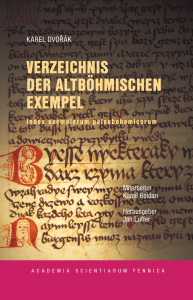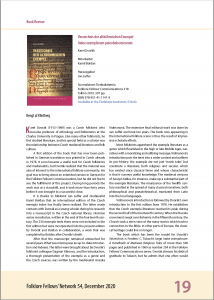Bengt af Klintberg
Karel Dvorák (1913–1989) was a Czech folklorist who became professor of ethnology and folkloristics at the Charles University in Prague. Like many other folklorists, he first studied literature, and his special field as a scholar was the relationship between Czech medieval literature and folk culture.
A first edition of the book that has now been published in German translation was printed in Czech already in 1978. It soon became a useful tool for Czech folklorists and medievalists, but Dvorák realized that the material was also of interest to the international folklore community. His goal was to bring about an extended version in German for the Folklore Fellows’ Communications, but he did not live to see the fulfillment of this project. During long periods the work was at a standstill, and it took more than forty years before it was brought to a successful close.
It is thanks to folklorist Jan Luffer and medievalist Kamil Boldan that an international edition of the Czech exempla index has finally been realized. The latter made contacts with Dvorák as a young scholar during his research into a manuscript in the Czech national library, Historiae variae moralisatae, written in the end of the fourteenth century. The 230 exempla texts there were not included in the first edition but were incorporated into the present edition by Dvorák and Boldan in collaboration, a work that was completed by Boldan after Dvorák’s death.
After that the manuscript remained untouched for several years. What was missing was an up-to-date introduction and indexes. The latter were brought about by Dvorák’s folklorist colleague Dagmar Klimova, and the introduction, a thorough presentation of the exempla as a genre and the Czech sources, was written by the medievalist Anezka Vidmanová. The extensive final editorial work was done by Jan Luffer and took ten years. The book now appearing in the international folklore scene is thus the result of impressive scholarly efforts.
Most folklorists apprehend the exempla literature as a genre which flourished in the high or late Middle Ages, narratives with a moralizing and edifying message. Vidmanová’s introduction puts the term into a wider context and outlines its pre-history: the exampla are not just “monk tales” but constitute a literature, both religious and secular, which has existed since classical times and whose characteristic is that it conveys useful knowledge. The medieval versions of Aesop’s fables, for instance, make up a substantial part of the exempla literature. The renaissance of the twelfth century resulted in the spread of many classical narratives, both philosophical and pseudohistorical, translated from Latin into the local languages.
Vidmanova’s introduction is followed by Dvorák’s own introduction to the first edition from 1978. He establishes that the Czech exempla literature reached its peak during the second half of the fourteenth century. When the Hussite movement swept over Bohemia in the fifteenth century, the Church took a stern view of the many stories which had no connection to the Bible. In other parts of Europe, the classical heritage could live on longer.
The book which has been the model for Dvorák’s Verzeichnis is Frederic C. Tubach’s large Index exemplorum: A Handbook of Medieval Religious Tales of more than 500 pages and published in 1969 as number 204 in the Folklore Fellows’ Communications series. Dvorák stresses his debt of gratitude to Tubach, but he admits that one often would like Tubach’s plot summaries to be more detailed. He also notes that additions could be made to Tubach’s references to secondary literature.
Like Tubach, Dvorák presents his material in alphabetical order. The most significant word in the caption of the exemplum decides its place. Dvorák has maintained Tubach’s type numbers and English captions, but the contents are summarized in German. The type numbers not found in the Czech material have been left out, but in return Dvorák has introduced a great many types not found in Index exemplorum. These have the same number as a caption with the same catchword, but an asterisk indicates that it is a new type. This can be illustrated through three exempla that have been adapted to Tubach’s type 23, “Abraham and wife Sarah”. This story from Genesis is missing from Dvorák’s material. He has, however, added 23*, “Abraham as a host”, 23**, “Abraham erecting the family tomb” and 23***, “Abraham’s sons”, none of which are in Tubach’s index.
After summaries of the contents follow references, first to Czech sources, thereafter to other sources where the narrative is found. This section is followed by references to secondary literature and finally also to proverb collections containing texts related to the exemplum in question. The last-mentioned information makes Dvorák’s index a useful aid for paremiologists.
How can a non-Czech folklorist use Dvorák’s Verzeichnis?
My impression is that all folklorists, regardless of specialization, will find something of interest among the more than a thousand narratives, some well-known, others never heard of. Those who have understood exempla as being religious narratives in a Christian setting will probably have to revise their opinion. To be sure, most of the stories, such as the animal fables which make up a substantial part of the index, are moralizing and edifying narratives, but they are not set in a religious context. One finds, as a matter of fact, types in Dvorák’s index which are neither religious nor narratives. This is especially true about some of the texts in Historiae that have no dramatic plot; they just mediate useful knowledge in general terms. For example, 4946*, ”Travelling in winter”, goes like this in translation: “He who undertakes a journey in winter must above all take heed not to become hungry on his way. With an empty stomach the natural bodily warmth disappears, which is what happens with the light in a lamp when the oil is gone.” A wise remark, to be sure, but there is no hint in the summary that this should be given a Christian interpretation.
Those readers who are folktale scholars will note that no less than 130 types have a number in Aarne-Thompson-Uther’s The Types of International Folktales. A comparison of the presentation in Dvorak’s Verzeichnis with the one in ATU shows that the information given is far from the same in the two handbooks. In some cases, it is more extensive in ATU, in others the Verzeichnis contains more details. This shows that folktale scholars have good reason to consult the Czech index.
As a random sample, I have compared the presentation of type 3378, “Monk Felix”, in Dvorák’s (and Tubach’s) index and the ATU type 471A, “The Monk and the Bird”. This well-known Christian legend is about a monk who listens to heavenly, beautiful bird song. When he returns to the monastery, it appears that several hundred years have passed. A folklorist who would like to investigate this legend should not forget to consult Dvorák’s index. It contains not only references to Czech variants in the collections “Arnesti Pragensis” and “Klaret” but also around ten references to literature which are not found in ATU.
My personal interest in contemporary narrative tradition made me note that some of the Czeck exempla have survived into our time. Here are three examples:
- 1482*, “Death, threefold, predetermined by fate”. – The son of a merchant is told that he will drown, die from being dragged after a wagon and be hanged. This story (ATU type 934) has a modern offspring in the story about a man who tries to commit suicide by simultaneously drowning, shooting and hanging himself but fails.
- 3251**, “Medicaments, interchanged”. – A mistake is committed at the drugstore: a knight who looks forward to a love night gets laxative instead of aphrodisiac and a monk with constipation gets the aphrodisiac. This burlesque story is still alive today.
- 5279*, “Wife instead of harlot on rendezvous with husband”. – A wife in disguise takes the place of a prostitute with whom her husband has arranged a rendezvous. Afterwards she reveals who she is and scolds him. In the contemporary versions the wife is a prostitute without her husband knowing it. He finds out this when he becomes her customer. The event has been reported in daily papers several times as a true story.
In the end of the book the reader finds three indexes. The first is a concordance with The Types of International Folktales. It shows that the most frequent folktale category in the exempla index are the animal tales, with 48 items. The second index is about the protagonists of the tales. Here one notices that persons from classical antiquity make up a larger portion than both Biblical persons and saints. One finds no less than 36 stories from the cycle of Alexander the Great, which could be compared to the only 19 stories about Christ. The third index is a detailed subject index running over 25 pages.
Indexes of the kind represented in this book have already from the very start been distinctive to the series Folklore Fellow’s Communications. Karel Dvorák’s Verzeichnis der altböhmischen Exempel, exemplarily edited by Jan Luffer, will without doubt stimulate research not only in the field of medieval exempla but in folktale research as a whole.


